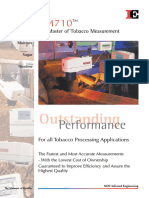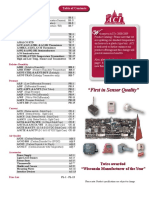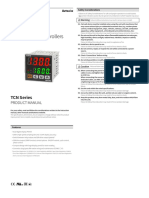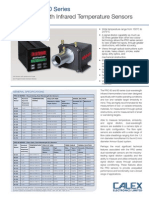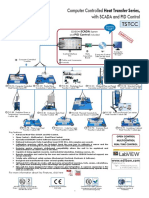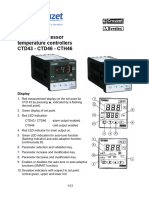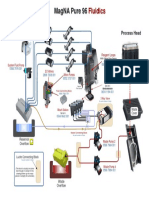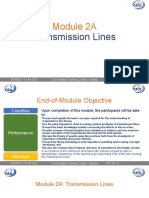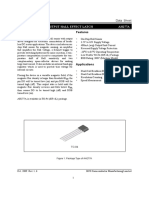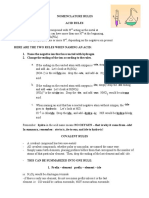Technical News Bulletin
Steinhausen, November 2020
Temperature Control – Automatic temperature measurement reduces work load to
control process
System – TCS – Multiple measurement points per section reduce downtime
– Automatic re-measuring when measurement is out of range
TNB215RevA
Page 1/7
�Introduction
The Temperature Control System (TCS) uses a high speed pyrometer mounted on an automatic positioning
system on the blank side. It measures blank mold, plunger and neck ring temperature. The different temperature
readings are displayed and recorded. These temperature readings give the process the transparency needed to
reduce blank mold, plunger and neck ring temperature variations and lead to improved process stability.
System description
By means of three axes, the pyrometer is accurately positioned to measure all blank mold and plunger
temperatures. The collected data is plotted on various graphs and a warning is activated if any of the
temperatures fall outside of the pre-set limits.
The system includes:
a) A three axis positioning system
The first “X” axis, is composed of a linear
rail, a stepper motor which drives a tooth
belt and, in turn, moves a carriage along
the linear rail that covers the full span of
the IS machine. An encoder is employed to
monitor the exact position of the carriage.
The second and third “Horizontal” and
“Vertical” axes include two precision
stepper motors with integrated gearing.
The two motors are mounted together onto
the X axis carriage. This particular
arrangement provides a pan and tilt
movement.
b) High speed infrared
pyrometer
The high speed pyrometer measures
temperature using an infrared wave length
of 1.45 μm, in a range of 350ºC to 1800°C.
The pyrometer is housed in a small
enclosure which has purge air
continuously running through it to clean the
lens and to cool the pyrometer.
TNB215
Page 2/7
�c) Ethernet Bus and PLC interface
The Ethernet Bus system controls the horizontal and vertical motors and transfers the pyrometer signals to the
PLC (programmable logic controller) interface.
The PLC commands the positioning of all axes, handles the temperature signal in real time, activates the TCS
alarm, processes the cycle trigger signal received from FlexIS for each independent section.
d) Hand-Held unit
The operator, standing in front of the machine, uses the hand-held
unit to move the three axes to position the pyrometer to a given
measurement location and to save its coordinates. A laser pointer,
which is internally fitted to the pyrometer, is used to verify the
viewing location of the pyrometer and to set up the measurement
locations.
From the hand-held terminal the user can switch on/off the laser
pointer and display the temperature received by the pyrometer.
e) User interface
The user interface provides the operator with a variety of software
features that automatically analyze and present the temperatures acquired on different screens in an easy to
understand way.
The “Overview” display provides the temperatures of the
various cavities for all the sections and a warning/alarm is
activated if any of the temperatures fall outside of the
predetermined set limits.
The “History” is a graphical display of the collected data over
time. Additionally, the minimum and maximum alarm limits
are shown using two horizontal red lines.
TNB215
Page 3/7
�Components Specification – TCS System Requirements 603-10015
User Console
Temperature: without air conditioner 0-40°C
with air conditioner 0-55°C
Humidity: without air conditioner 10-80% non-condensing
with air conditioner 10-100%
Power consumption/supply 110 - 240V AC single phase, 1kVA; 48-62Hz
Line voltage tolerance -10%/+15%
Protection grade: IP65
Control Cabinet
Temperature: max. 60 °C housing cover surface
max. 55 °C inside cabinet
Humidity: relative 20 – 95 % non-condensing
Power consumption/supply: 110 - 240V AC single phase, 0.5 kW, 50 Hz
Protection grade IP 66
Hand Held Terminal
Temperature: max. 60 °C housing cover surface
Humidity: relative 20 – 95 % non-condensing
Power consumption/supply: 24 V DC supplied through Control Cabinet
Vibration and mechanical shock: 5-100Hz 19,6m/s² or 1,5mm amplitude,
Diskless design, but limitation
by TFT display &
internal ventilation: 10-55Hz 539m/s² 11ms (whatever applies first)
Protection grade IP 66
TNB215
Page 4/7
�Linear Module
Temperature: max. 60 °C
Humidity: relative 20 – 95 % non-condensing (<70g/m³)
Power consumption/supply: 24 V DC supplied through Control Cabinet
Protection grade: IP65 (all connectors/covers properly attached)
TNB215
Page 5/7
�Measuring Head, including Pyrometer and Terminal Box
Temperature: max. 60 °C cable track chain
Humidity: relative 20 – 95 % non-condensing
Power consumption/supply: 24 V DC supplied through Control Cabinet
Protection grade: IP65 (all connectors/covers properly attached)
Pneumatic supply
pressure/consumption 3.2 bar 280 Nl/min
Air requirement ISO Class 4 (ISO-8573-1)
Air temperature max 40°C
VORTEX Cooler KIT is required if the Air temperature at the TCS head
is >50°C
Temp. Measurement range: 350 to 1800 deg. Celsius
Control Interface
Input per Section
Timing signal (trigger) 24V DC (>10ms)
Delivery depending signal 24V DC (>10ms)
Swab depending signal 24V DC (>10ms)
Availability / Application
The TCS is available for the AIS/NIS machine types from 8 to 12 sections. For IS (Arcuate) machines availability
is confirmed only after technical study and application restrictions investigated. Not all cavities will have the same
measurement capabilities due to the design of the hinged mold holder.
The drawing 603-1-00 TCS Master Assembly shows the list of the components needed to install TCS. The
drawing 603-2-00 contains the mounting parts for each blankside panel, spare part references and electrical
schematics.
Layout and dimensions can be found on:
200-1973-00 AIS installation
400-5377-00 NIS installation
For installation on machines with legacy blank panels see layouts on 603-2-00.
All the TCS ordered with new machines will be assembled in the Emhart workshops according to the
corresponding layout.
During the preparation of the machine installation layout, to design the gob distributor platform and the cullet
chute, the position of the TCS and blankside panel is considered, indicated in the above installation drawing.
TNB215
Page 6/7
�Features / Benefits
Features Benefits
Automatic temperature measurement Reduces work load to control the process
Multiple measurement points per section Reduces downtime
Warnings and alarms for violation of set temperature Valuable Information to maintain constant mold
range equipment temperatures
Automatic re-measuring when measurement is out of
Device for the FlexIS close loop temperature control
range
Save reference temperatures as comparison
Real-time point measurement
Individual temperature limits
TNB215
Page 7/7




